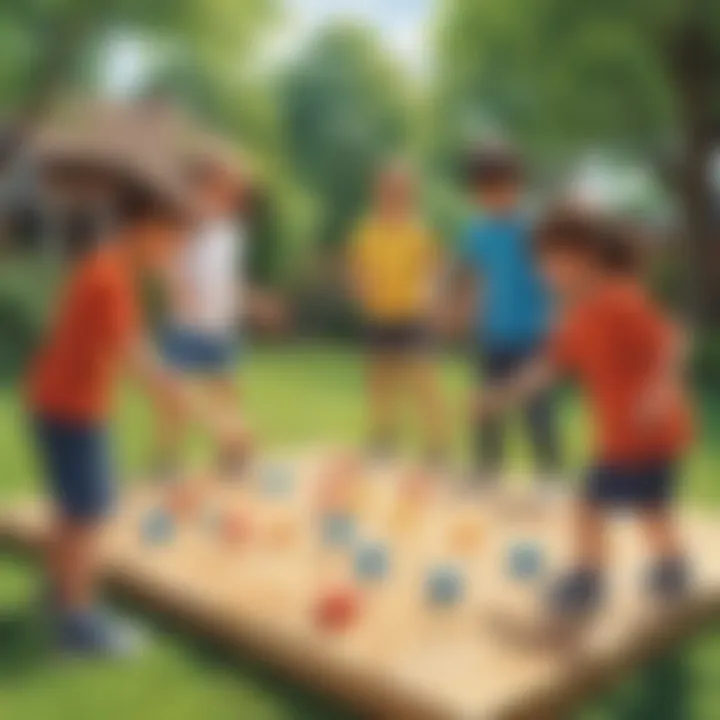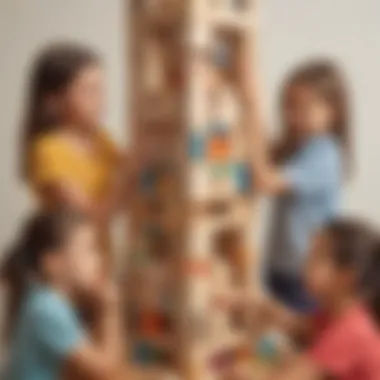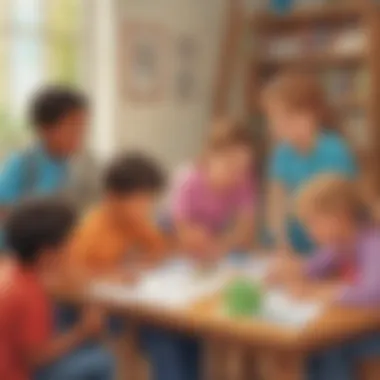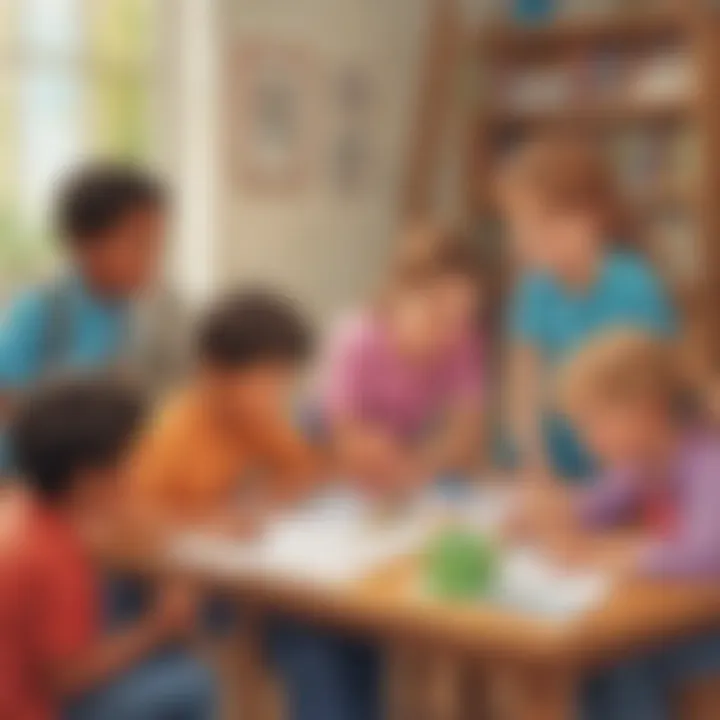Engaging Team Building Activities for Young Learners


Intro
Engaging young learners through team building activities sparks creativity and nurtures social skills. When children work together, they learn not just to cooperate but also to communicate effectively. The significance of teamwork can't be overstated; it equips them with essential problem-solving abilities they will carry into adulthood. Moreover, such activities are enjoyable and impart valuable lessons in collaboration and respect for different perspectives.
This article takes a closer look at a variety of team building activities specially designed for elementary school students. It offers practical insights for educators and parents on how to easily adopt these activities within different contexts. From creative crafts to fun quizzes, we will cover various aspects that promote teamwork and learning, ensuring both fun and educational outcomes.
Creative Activities
Creative activities can be a wonderful way to spark imagination in young minds while building strong team dynamics. Crafting encourages collaboration and communication, and the outcome can be as colorful as the children’s imaginations.
Craft Ideas
- Friendship Bracelets: Using yarn or colorful strings, children can make bracelets by tying knots together, symbolizing their friendship.
- Team Murals: Provide each child a canvas to paint or draw something that represents teamwork. They can work individually but combine their pieces afterward to create a larger mural.
- Recycled Art: Gather various recycled materials such as plastic bottles and cardboard. Let the children brainstorm and create inventive sculptures that illustrate their ideas on teamwork.
Step-by-Step Guides
- Friendship Bracelets:
- Team Murals:
- Recycled Art:
- Gather your materials: strings or yarn in multiple colors.
- Divide the children into pairs; they can choose a color combination together.
- Show them how to tie the knots, and let them work side by side.
- Set up a big sheet of paper or canvas in a common area.
- Assign a theme that revolves around teamwork.
- Let the kids discuss amongst themselves and create their individual pieces. Collectively they hang their creations together.
- Ask each child to bring in a piece of recyclable material.
- Create teams and assign certain materials to each group.
- Encourage brainstorming sessions to develop a concept for their sculpture.
Educational Value
Engaging in these crafts lays the groundwork for several educational benefits. Children enhance their fine motor skills through crafting; they learn patience and practice following instructions. Moreover, discussing their creations boosts their communication skills and fosters a sense of community. By collaborating on projects, they also grasp the value of compromise and the joy of shared success.
Finale
Incorporating these creative team building activities into educational settings can significantly enrich young learners’ experiences. Through crafts that require cooperation, children develop a myriad of skills that serve them well beyond their formative years.
Understanding the Importance of Team Building
Team building among young learners is more than just a buzzword in the education sector. It’s a vital ingredient in nurturing a cooperative spirit, aiding children in realizing the immense value of working together. Engaging in team-building activities can spark enthusiasm in shared goals and responsibilities, leading to a dynamic learning environment. This forms the cornerstone of their social and cognitive development, which manifests in various aspects of their lives.
Cognitive Benefits
When children participate in collaborative activities, their brains become engaged in ways that solitary tasks often don’t facilitate. For instance, solving problems together during a game not only enhances critical thinking but also encourages creativity. They learn to approach problems from diverse perspectives, mixing their own ideas with those of their peers. This cognitive interplay sharpens their analytical skills, making them better equipped to tackle academic challenges ahead.
Moreover, engaging with team members requires listening and concentration, essential skills in any learning atmosphere. Consider a scenario where kids work on a puzzle as a group; they must communicate openly about strategies and solutions, ensuring everyone’s voice is heard. Such activities lay the groundwork for developing cognitive flexibility and judgement, as they learn to adapt their thoughts according to group dynamics.
Social Skills Development
Team building activities serve as a platform for nurturing various social skills among young learners. Through these interactions, children pick up non-verbal cues and understand the power of body language. In a game setting, they learn to navigate relationships, recognizing that cooperation can lead to joint success, which is profoundly rewarding.
Inclusion is key here. If a child feels left out, it can affect not just their engagement but their self-esteem too. Thus, fostering an inclusive environment within team activities teaches empathy, respect, and the importance of valuing diverse contributions. Think about a role-playing scenario; while acting out different parts, children experience various roles and perspectives, enhancing their understanding of teamwork and community.
Emotional Growth
Emotional growth is another crucial aspect that transforms through team building. Engaging in activities together teaches children about feelings—both their own and those of their peers. They learn how to express their feelings and manage frustrations in a team context, which is a significant part of emotional intelligence.
For instance, the Human Knot game poses a challenge where children must untangle themselves without letting go of each other’s hands. This activity isn’t just physically engaging; it’s also a test of patience and resilience. Failing to succeed initially teaches them that mistakes are part of the learning process and encourages persistence, which is critical for emotional maturity.
In summary, team building for young children fosters cognitive development, enhances social skills, and supports emotional growth, setting the stage for life-long learning and collaboration.
All these elements combine to create not just competent learners but well-rounded individuals ready to take on the world. As the saying goes, ‘It takes a village’—and within this context, the village is often found in the playroom or classroom.
Key Principles of Effective Team Building Activities
In the world of team building, especially for young learners, certain principles stand out as essential. These principles not only lay the groundwork for fun and engaging activities but also ensure that the experiences are enriching and beneficial for all participants. Understanding these key aspects is crucial in maximizing the impact of any team building exercise. Let's explore these principles in detail, focusing on inclusivity, goal orientation, and the fun factor.
Inclusivity
Inclusivity is perhaps the cornerstone of effective team building activities. When planning exercises, it’s critical to consider every child’s background and abilities. Activities should be designed to allow every participant to contribute in a meaningful way, making them feel valued and included.
Aiming for a diverse mix of team members can promote a richer experience. For instance, activities that allow for roles based on each child's strengths foster a collaborative environment. Instead of pitting kids against each other, think of scenarios where they can support one another. This way, the shy kids can shine while also boosting the confidence of those who are more outspoken.
To create inclusiveness:


- Encourage diverse teams: Mix different ages, genders, and skill levels.
- Modify activities: Ensure that all activities can be tailor-made to suit various needs.
- Emphasize cooperation: Highlight the importance of working together, instead of just winning.
By keeping inclusivity front and center, you not only enhance communication but also foster relationships among youngsters, which can have lasting effects beyond the classroom.
Goal Orientation
Without direction, team-building activities can end up feeling aimless. Setting clear goals ensures everyone knows what they're working towards, which can make the experience more engaging and rewarding. Goal orientation, in this context, means not just having a result in mind, but also tailoring activities to develop specific skills, such as leadership, teamwork, or problem-solving.
Consider organizing a scavenger hunt where kids must work together to complete a task list. In this scenario, the goal isn't merely to find the items but to learn about strategizing and coordinating as a team. Goals should be Specific, Measurable, Achievable, Relevant, and Time-bound (SMART) for them to be truly effective.
Here are some ways to integrate goal orientation effectively:
- Set specific objectives: For example, enhance communication skills by discussing each team member's favorite objects during an activity.
- Track progress: Have teams check off their accomplishments, reinforcing their sense of achievement.
- Celebrate success: Recognizing completion of goals not only rewards kids but also encourages them to strive for success in future activities.
By having a clear target, participants will feel a sense of purpose, making the experience more gratifying and ultimately more impactful.
Fun Factor
Finally, let’s not forget about the fun factor, which is absolutely crucial when dealing with young learners. If an activity feels like a chore, it can quickly lose its appeal. Therefore, incorporating elements of enjoyment can transform a standard exercise into something delightful. Kids should come away from these activities not just having learned something but also feeling like they had a blast doing it.
Adding a twist, like a splash of friendly competition or a humorous theme, can heighten engagement. Think about activities like a balloon tower building challenge, where the pressure is on, but the laughter is abundant. The fun factor makes learning more enjoyable and encourages greater participation.
To keep the fun alive in any activity:
- Incorporate games: Kids love a good game; blend tasks with play.
- Use humor: A light-hearted approach can lift spirits and make kids feel at ease.
- Keep it dynamic: Vary activities to avoid monotony. Don’t let the humor or fun run dry.
Fun should be the adhesive that keeps everything together, making learning memorable and creating enjoyable moments that children will cherish.
By focusing on inclusivity, goal orientation, and the fun factor in team building activities, educators and parents can create a supportive learning environment that enables young learners to thrive while also having a great time.
Incorporating these principles into team building will not only enhance the effectiveness of the activities but also contribute positively to the overall development of children.
Easy Team Building Activities for Elementary Students
In the world of young learners, the way to a child’s heart is often paved with creativity and fun. Easy team building activities are not just a break from routine; they are essential in nurturing teamwork, communication, and problem-solving skills. When children come together in a playful setting, they learn to collaborate, respect each other's ideas, and build trust. These activities are also key in developing a positive learning environment as they help eliminate barriers that often exist between different groups of students.
By implementing straightforward and engaging activities, educators and parents can transform mundane lessons into exciting adventures. This segment will explore various enjoyable team building exercises that focus on cooperation and creativity, all while making sure to keep the enjoyment factor high.
Group Storytelling
Group storytelling is a fantastic way to spark imagination and teamwork among elementary students. In this activity, children can sit in a circle and collectively create a story, each contributing a sentence or phrase. This not only enhances their narrative skills but also encourages them to listen actively and think critically about their peers' contributions.
Benefits of Group Storytelling:
- Encourages creativity: Children learn to build on each other's ideas, creating a cohesive narrative.
- Boosts communication: It enhances verbal skills as each student must articulate their thoughts.
- Fosters inclusivity: Every voice is important, making sure all students feel valued.
Puzzle Challenges
Puzzle challenges bring an intriguing twist to teamwork. Set up several puzzles around the room and divide students into small groups. Each group must work together to solve their puzzle, competing against others to finish first. This activity not only sharpens their problem-solving capabilities but also teaches the importance of dividing tasks and sharing roles effectively.
Key Considerations for Puzzle Challenges:
- Select age-appropriate puzzles: Make sure the puzzles are neither too easy nor too complex.
- Group dynamics: Mix children from different grades or backgrounds to enrich the experience.
Team Scavenger Hunts
Team scavenger hunts are not just about finding items; they are mini-adventures that cultivate exploration and camaraderie. These hunts can take place within the classroom or in a nearby park. Provide clues or riddles that lead to different 'treasures,' encouraging students to work together while moving around.
Why Scavenger Hunts Work Well:
- Active participation: Kids love to run around and discover hidden treasures.
- Problem-solving skills: They learn to interpret clues and strategize their approach.
- Teamwork in action: The shared excitement and competition bolster group spirit.
Creative Arts and Crafts
Creative arts and crafts sessions are an excellent platform for children to express themselves collectively. Organizing a project where small groups create a mural or a giant collage allows each child to contribute their unique flair. They learn to share materials, brainstorm ideas, and provide feedback to one another, enhancing their collaborative skills.
Implementation Tips for Arts and Crafts Projects:
- Choose a theme: It helps to guide their creativity.
- Include diverse materials: Varied supplies can cater to different artistic preferences and push boundaries.
Role-Playing Scenarios


Role-playing scenarios provide a unique method for children to engage in teamwork while exploring different situations. Have students act out everyday conflicts or challenges, allowing them to brainstorm solutions together. This method fosters empathy and helps them understand multiple perspectives.
Benefits of Role-Playing:
- Empathy Development: Understanding roles helps children appreciate others’ viewpoints.
- Collaboration Skills: Working together in building scenarios enhances teamwork.
Engaging in these easy team building activities can lead to long-lasting benefits for elementary students, shaping the way they interact and connect with their peers. By prioritizing fun and purposeful exercises, we lay down the foundation for essential life skills that they will carry forward.
Fun-Focused Activities to Enhance Collaboration
Engaging young learners in team activities can be a delightful mix of fun and learning, particularly when focusing on collaborative skills. These activities serve not just to entertain but to lay down a fundamental groundwork for cooperation and communication among children. The most captivating aspect of these fun-focused initiatives is that they naturally attract children's enthusiasm, making them more inclined to participate wholeheartedly. The shared laughter and moments of triumph during these exercises foster a sense of belonging and collective purpose, reinforcing the idea that success is often a team effort. Furthermore, the informal atmosphere encourages kids to step out of their comfort zones, ultimately boosting their confidence in social settings.
Balloon Tower Building
In this lively activity, groups of young learners are given a challenging task: build the tallest tower they can using only balloons and tape. It's a race against the clock! As they gather materials and form strategies, the kids must communicate constantly about their ideas, assessing each other's contributions. This exercise is rich in problem-solving opportunities, as they may hit obstacles—such as a tower that doesn't stand up all that well.
- Key Elements:
- Materials Needed: Balloons, tape, and perhaps scissors for adding some flair.
- Team Size: Best with teams of three to five.
- Duration: A quick 30 minutes should do it!
The element of fun comes from the competitive spirit, yet the real value emerges through their collaboration. They learn how to actively listen, share ideas, and even negotiate, all while being creative. Planning is essential; the groups must lay out their designs and execute them while adapting to unexpected challenges.
Human Knot
The Human Knot activity is a classic that’s both chaotic and incredibly fun. Participants stand in a circle and join hands with two different people across from them without letting go. The goal? Untangle this human puzzle without losing grip of each other’s hands. Sounds simple, right? But it can quickly grow complex!
The strength of this game lies in how it encourages communication. While twisting and turning, learners must vocalize their thoughts, sharing strategies and ideas for untangling. Trust emerges as a core element—after all, they're relying on each other to help navigate through the twists and turns.
- Key Elements:
- Number of Participants: Ideal for groups of six or more.
- Space Required: An open area to allow freedom of movement.
- Duration: About 10-15 minutes will keep spirits high.
The Human Knot not only sharpens communication skills but also promotes patience as the team works through trial and error to unravel the knot.
Team Relay Races
Picture a vibrant field bustling with energy as young learners gear up for relay races. In this activity, teamwork shines as children take turns completing a series of tasks, which might range from a simple sprint to balancing an egg on a spoon. Each team races against the clock and other teams, fostering a sense of urgency but more importantly—cooperation.
- Key Elements:
- Materials Needed: Egg and spoon, cones for marking distance, or any fun props available at hand.
- Team Size: Works well with small to medium-sized teams, ideally four to six kids.
- Duration: About 20-30 minutes fosters excitement without overwhelming.
Through relay races, children learn to support one another, cheering for their teammates and celebrating their collective achievements. This environment helps develop a strong team spirit while also implementing fundamental athletic skills. The element of competition adds an extra layer of motivation, but the true treasure is the bond they build during these playful and spirited challenges.
"Teamwork divides the task and multiplies the success!"
All these activities emphasize the essence of collaboration, making the learning process enjoyable. In fostering teamwork in a playful setting, these activities can lay the groundwork for essential social skills that young learners will carry well into their future.
Outdoor Activities to Foster Team Spirit
Engaging in outdoor activities is an excellent way to foster team spirit among young learners. The fresh air and natural surroundings can rejuvenate the mind, while also offering a unique setting for kids to bond, learn, and grow. The importance of outdoor activities in team building rests on their ability to encourage collaboration and communication while providing an opportunity for children to explore the world around them. Engaging with peers in a non-classroom setting creates a relaxed atmosphere, making it easier for them to forge connections and strengthen social bonds.
Benefits of outdoor team building activities include:
- Physical Engagement: Kids get to move around, which aids in their overall health and well-being. This is crucial in a digital age where screens dominate.
- Enhanced Cooperation: Tasks undertaken outdoors often require children to work together, significantly increasing their cooperative skills.
- Creative Problem Solving: Nature can present challenges that require inventive solutions—from figuring out how to navigate a path to completing a scavenger hunt, creativity is essential.
- Building Trust: Trust naturally develops when children rely on one another to accomplish shared goals.
These activities can also be tailored to various age groups, ensuring that every child feels included and valuable. They offer an ideal blend of learning objectives wrapped up in enjoyment. Let's delve into a couple of specific outdoor activities that can effectively nurture teamwork.
Nature Walks with Group Tasks
Nature walks combined with group tasks present a simple yet effective way to promote team bonding among young learners. This leisurely activity encourages kids to take in their natural environment while simultaneously working together to complete certain challenges.
How It Works: Before heading out, teachers or facilitators can prepare a list of tasks or mini-challenges. These could include items like identifying different types of leaves, spotting specific wildlife, or even taking photos of various flowers. By dividing the children into teams, they not only enjoy the fresh air but also develop observational skills and cooperation as they strive to complete their challenges.
Benefits of these nature walks include:
- Sensory Learning: Children engage their senses by touching, seeing, and hearing elements of nature, enriching their learning experiences.
- Physical Exercise: Walking is a natural form of exercise, promoting fitness without being perceived as a chore.
- Mindfulness: Being outdoors can allow children to reflect on their surroundings, promoting a sense of calm and mindfulness in their daily lives.
Obstacle Course Challenges
Obstacle course challenges are another fantastic method to bolster team spirit. Creating a fun yet challenging course encourages kids to face physical obstacles together. They not only push their own limits but also lean on their teammates for support and motivation.


Setting Up the Course: Teachers or parents can design the obstacle course using materials like cones, ropes, tires, or even pool noodles. Challenges can include crawling under a rope, balancing on a beam, or running slalom-style between cones. Once organized, children can be divided into teams to tackle the course in relay style, encouraging cheering and support from teammates.
The advantages of an obstacle course for team building are numerous:
- Teamwork Under Pressure: Children experience the importance of communicating effectively while racing against the clock.
- Boosting Confidence: Conquering obstacles together ultimately boosts self-esteem, especially for children who might hesitate in individual performances.
- Fun and Friendly Competition: This activity brings an element of excitement through friendly competition while reinforcing a collaborative spirit.
In essence, outdoor activities like nature walks with group tasks and obstacle course challenges serve as more than just play; they are instrumental in nurturing cooperation, communication, and team spirit among young learners.
Incorporating Technology into Team Building
In an increasingly digital world, integrating technology into team building activities offers myriad advantages for young learners. It not only caters to their familiarity with gadgets but also aligns with modern teaching strategies. Engaging with technology can make team building more accessible, interactive, and stimulating. With the right approach, educators can harness technology to enhance essential teamwork skills while keeping the enthusiasm alive in the classroom.
Virtual Team Games
Virtual team games are an excellent way to create a sense of community and collaboration among young learners, even when they can't be physically close. These activities can range from online trivia contests to classic games like charades, all played via a video call. The importance lies in their capability to break down barriers, as children from different backgrounds can come together to participate on an equal footing.
Here are a few benefits of virtual team games:
- Boost Engagement: Young learners tend to show more interest when technology is involved. Virtual games capture their attention and make learning enjoyable.
- Flexible Scheduling: Unlike traditional activities, virtual games can be scheduled to fit within the school's constraints or at home with a parent. Thus, they offer greater versatility.
- Social Interaction: These games encourage kids to communicate and cooperate, refining their social skills while having fun.
A simple example of a virtual team game is a digital scavenger hunt, where kids are given a list of items to find in their homes or surroundings and share via video. This game does not only demand teamwork but also creative thinking.
Online Collaborative Projects
Another idea is to use online platforms for collaborative projects. This approach not only promotes teamwork but also incorporates educational content, helping learners grasp vital concepts while collaborating. Platforms such as Google Docs or various educational apps allow for real-time cooperation where kids can contribute equally.
Online collaborative projects can foster:
- Creativity: Working together on a shared document encourages students to brainstorm, develop ideas, and think outside the box.
- Responsibility: When kids depend on one another to complete tasks, they learn accountability and the value of meeting deadlines.
- Diverse Learning Styles: Each child can contribute in a way that suits their strengths, whether through writing, drawing, or crafting presentations.
An example project might involve researching an animal; students can create a shared presentation, adding their findings and illustrations. This not only nurtures their research capabilities but enhances communication.
"Incorporating technology into team-building may seem daunting at first, but with the right tools, it can be a seamless part of any educational experience."
Embracing technology in team-building activities helps prepare young learners for a world where collaboration often occurs in digital environments. As these kids learn to navigate these tools effectively, they're not just engaging in fun games; they're also developing skills that will serve them well in their future endeavors.
Evaluating Team Building Activities
Evaluating team building activities is a fundamental step in understanding their effectiveness and impact on young learners. It's not just a matter of conducting activities and moving on; assessing these exercises helps in fine-tuning them to better fit the needs of the children involved. It’s like sharpening your tools before starting a project. When teachers and parents take the time to evaluate these activities, they can see what works well, what doesn’t, and ultimately how to make them more engaging and beneficial.
Gathering Feedback
Feedback is the lifeblood of improvement. To truly understand how a team building activity resonates with kids, gathering feedback is crucial. This can be done through various methods:
- Direct Conversations: Ask the children what they liked or didn’t like about the activity. Sometimes, just hearing it straight from them can reveal insights that are not apparent.
- Surveys: Create simple, kid-friendly surveys that allow kids to express their opinions on different aspects of the activities. This method works great because it gives every child a voice, regardless of how shy they might be.
- Observation: Sometimes, the best feedback comes from simply watching interactions during activities. Are students smiling? Are they engaged?
Teachers can ask questions like, "What was your favorite part of today’s activity?" or "If you could change one thing, what would it be?" This simple dialogue helps realize what aspects are effective and which can be improved upon.
Observing Changes in Dynamics
The dynamics of a group can shift considerably during team building activities. These changes can signal the success of the activity or highlight areas for adjustment.
Observing how young learners interact can reveal several critical points:
- Communication: Notice if students are talking to each other more openly, sharing ideas, or asking questions. A noticeable increase in communication can indicate that the activity encourages dialogue.
- Collaboration: Pay attention to how well students work together. Are they taking on roles within a team? Are they strategizing together?
- Conflict Resolution: Activities can sometimes lead to disagreements. The ability of a group to resolve issues amicably is a positive sign of growth.
It’s important to capture these observations. Taking notes or discussing them in teacher meetings helps maintain a focused approach on the team building initiatives at hand. Over time, as assessments are made, patterns will emerge that demonstrate clear changes in dynamics, signaling the success of the team building activities.
"Effective team building activities do more than entertain; they create an environment ripe for growth, communication, and collaboration among our young learners."
By evaluating feedback and observational insights, educators can continuously refine their approach, ensuring team building activities remain valuable and truly beneficial to young learners.
Closure: The Lasting Impact of Team Building
In summing up the importance of team building activities for young learners, we step back to appreciate the profound effects these experiences have on children. When kids engage in collaborative tasks, they don’t just learn how to work with others; they develop skills that carry weight far beyond the classroom walls.
One striking aspect of team building is its ability to create a sense of belonging. Young learners who participate in these activities often report feeling more connected to their peers. This emotional boost is significant as it fosters a supportive environment where children feel free to express themselves. With increased trust among team members, kids are likely to shoulder challenges together, making tough tasks seem less daunting.
Moreover, the cognitive gains from these activities cannot be overstated. Teaching students how to strategize in group settings sharpens their problem-solving and critical thinking skills. A child might learn that gathering input from team members, embracing diverse viewpoints, and collectively brainstorming leads to better results than going solo. This promotes the idea that "two heads are better than one," a phrase that also resonates with young minds open to exploring different ideas.
"Teamwork is the fuel that allows common people to attain uncommon results."
In addition to cognitive and emotional growth, team building enhances communication skills. When children practice articulating their thoughts and listening to others, they develop a confidence that’s indispensable in both academic and social environments. Skills such as negotiating, presenting ideas, and understanding non-verbal cues are fostered during group activities, setting the groundwork for effective interpersonal communication later in life.
For parents and educators, integrating team building activities into the routine can be contextually rewarding. The effort spent nurturing these skills bears fruit not only in academic settings but also in everyday interactions. It’s a long-lasting investment in a child's ability to collaborate and negotiate, skills that employers continuously seek in today's world.
Ultimately, the essence of team building lies in learning how to truly connect with peers. Schools and homes that place emphasis on these skills help lay the foundation for a generation that values cooperation over competition. As we put the spotlight on these pivotal formative years, let’s remember that the lessons learned in teamwork today will echo in the decisions, relationships, and challenges faced in the future.







